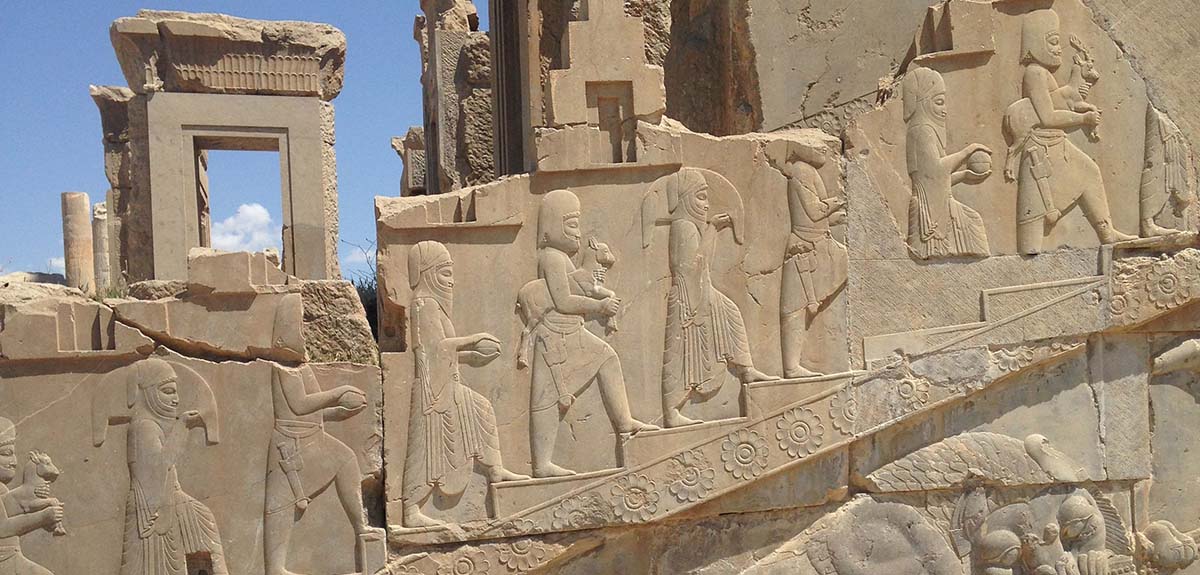
by Maureen Moss
I feel nervous as I disembark from the plane; I have just flown into Tehran International airport from Kiev in Ukraine, and I am alone. I’m wearing a full-length kaftan and have a headscarf positioned over my hair, to blend in with all the women disembarking (they all covered their heads at the last moment before exiting the aircraft). I was expecting to be stopped, and questioned about my single traveller status, the purpose of my visit, and maybe be fingerprinted. But no; there are very few people about at 01.30, and the immigration officer casts a cursory eye over my passport and visa, then waves me forward with a smile. More welcoming than in UK or USA, then. As I exit the arrivals hall, a beaming, tall man holds up a sign with my name on. I let out a sigh of relief. I am here, in Iran! Askar whisks me into his car and off we drive, into the dark night, passing a huge floodlit edifice that Askar informs me is the Imam Khomeini mausoleum. It looks beautifully elegant against the black night sky.
I check in to the Saina hotel, acquire the free WIFI password, and open the door to my enormous, richly decorated room. I sink into a luxuriously deep bath, and quickly retire into my huge double bed to slumber with relief that all has gone well, until 08.00. Breakfast is fresh fruit, followed by beans and mushrooms, plus scrambled eggs with tomato. I won’t starve, then. Instead of my nemesis -butter- I choose sesame spread to put on my naan bread, and it is as delicious as I expected. It is Ramadan, and I am both surprised and delighted to have such a luxurious breakfast buffet to choose from.
At 09.30 I amble into the foyer to meet my guide, and almost stop in my tracks. She is beautiful. Like a delicate flower, seated patiently on a small settee in the reception area. She is called Saba, and I learn later that she is one of Iran’s top guides. How lucky am I? We start to walk and pass a musician playing the Santour; its melodic sound soothes me as we wander on through the streets where five lanes of traffic trundle noisily past us. To cross, Saba simply holds up her arm and steps off the kerb, keeping her hand high to signal that the traffic should wind past her as she strolls casually across. And they do.
Everyone here smiles at me as if I am a long lost, dear friend. In the Golestan Palace I gasp at the glass mirrors reflecting every wall and ceiling: it is like being inside a diamond. We visit the Iran National museum and the Malek museum, where I see a skull complete with its original facial skin. There follows the Jewellery museum, to admire the riches of various dynasties – including a 2.5 cm square, 180 carat rose diamond whose other half sits in London, England – and finally, a stroll through the bazaar, where I watch a group of five burka-clad women chattering as they walk. Saba informs me that only deeply religious women wear this garment these days. I ask her about an interview I read recently in which it was implied that there are not many women tour guides in Iran. She smiled and shook her head. ‘We are many,’ she said. ‘It is quite a normal employment for women.’
Saba has an extra sight for me to enjoy: the ‘Nature Bridge’, lined with flowers, where I revel in delicious scents and extensive green valley views with a 5,800 metre mountain – Iran’s highest – towering in the distance.
We grab a snack of cheese and honey with special Ramadan sweets at the national airport as Saba has warned me that the in-flight dinner will be, shall we say – average. And she is right, it is.
I now find myself in another gorgeous room at the Karim Khan hotel in Shiraz, and after a deep sleep I am enjoying another sumptuous breakfast buffet. Our driver this time is Shahab – a jolly photo journalist with an irresistible smile. Askar will wait for me in Tehran to make sure I get back to the international airport safely. It turns out he is an ex-army general!
We visit the ancient baths, where a story teller used to come and sit with the men, bringing with him a painted curtain to illustrate his stories as he spoke. The men would come here in the morning, and after a few hours would stroll on to the bazaar, sated with stories to share, whilst the women would then take their place, to sit and gossip together for the rest of the afternoon.
In the garden of Karim Khan (doesn’t that sound exotic?) the scent of roses is overpowering – sweet and heady. The peace I feel is overwhelming, and I want to never leave. We visit a mosque, where tranquility oozes from its pink tiles, and then after a quick visit to the bazaar, we drive out to a wooded area for a picnic of Kalam Polo cabbage rice and Tah Chin rice cake with chicken. Delicious. Shahab has a fantastic fold-away picnic table that fits into the back of the car and seats four adults comfortably. I make a note to order one when I get home. After lunch we go back into Shiraz town to walk through Eram botanical garden and on to the poet Hafez’ tomb. Here, I am transfixed, overwhelmed with emotion. This is one of my most moving experiences ever. The love is almost tangible, like electricity in the air, from the moment we start to climb the steps up to the tomb. In the perfect calm, tears of happiness and love flow from somewhere deep in my soul. I will never forget this place.
We refresh ourselves with tea and Ramadan biscuits inside Ali Ebn Hamze mausoleum, where a glorious amount of crystal and glass dazzles me, and a long talk with a Shi’ite cleric bores me to numbness. I had asked him to explain the difference between Shi’ites and Sunnis, and he was clearly biased towards the former. Back at the hotel I meet with the lovely Samaneh, with whom I’ve planned this tour by email over a period of many months. She gifts me an inlaid wooden penholder which will sit alongside my computer: the sublimely old and the ultra-modern.
Next morning, I choose raw broccoli and cream cheese for breakfast: a ‘never-been-done-before’. I follow it with Ash e Sabzi herb soup, to fortify myself for the long drive to Persepolis. We will be on the road all day.
Approaching the site of the ancient Persian capital of which I’ve heard so much (and, being a fan of old stones, is the main motive for my visit), I am immediately impressed by the sheer size of it. I expected it to be much smaller. I have seen many pictures of visitors bringing gifts to the king, their images carved into a long wall for eternity, and they do not disappoint. Once again, I feel stirred with wonder, as I close my eyes and imagine the crowds going about their business here some 2,500 years ago. The king would have distinguished guests – from his own kingdom and beyond – wait in a large reception hall, and would make a grand entrance, sweeping in from his own quarters, surrounded by his servants and women. The site was mainly used for ceremonies, so the steps are shallow – no one should trip over a flowing robe: that would be highly undignified.
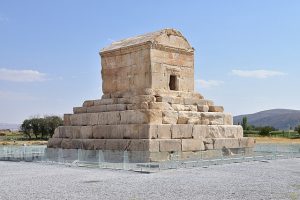 We drive away, and on through deserted scrubland to the Necropolis and Pasargadae to see Cyrus the Great’s tomb. He was a real good guy, it seems, beloved and respected by everyone for his pursuit of justice. It was he who made the very first Declaration of Human Rights. As we step away from the tomb, a young girl approaches me shyly to ask where I am from. After a brief exchange of words, she begins to sing to me in English! Her family stand around her, smiling proudly, whilst I listen, grinning in appreciation.
We drive away, and on through deserted scrubland to the Necropolis and Pasargadae to see Cyrus the Great’s tomb. He was a real good guy, it seems, beloved and respected by everyone for his pursuit of justice. It was he who made the very first Declaration of Human Rights. As we step away from the tomb, a young girl approaches me shyly to ask where I am from. After a brief exchange of words, she begins to sing to me in English! Her family stand around her, smiling proudly, whilst I listen, grinning in appreciation.
I am surprised when we pull into what is obviously a restaurant, where the tables are arranged beneath shade-giving trees. It’s a welcome sight after the barren landscape en route.
‘As we are travelling, we are permitted to eat during Ramadan,’ Saba explains. ’There are special travellers’ restaurants, and this is one of them.’ It is a buffet, and I opt for barley soup and a herb stew called Gotmesabzy (I think), with rice. Unfortunately, Shahab is stopped by the police once we are back on the road – for speeding. He gives a philosophical shrug and hands over the fine. After five hours of driving we pull into a roadside shack where Shahab believes he will find petrol, and Saba and I drink hot chocolate whilst he negotiates a deal.
We arrive at the Setareh hotel in Isfahan at 9.00pm after a supper of cashew nuts in the car.
By now I have my four key words for Iran: music, roses, smiles, love. Lilting music, the scent of roses, the welcoming smiles that light up whole faces, and pure love in the air at every turn.
And yet, there is more to come!
As my last full day dawns, I have to make a call to Ukraine International Airways to enquire about my boarding pass for the return flight from Tehran tomorrow morning. Eventually I reach the right person and we can proceed with our sight-seeing. After talking on a mobile about air travel it feels like returning from a futuristic movie. I stop at a small shop to buy scarves; I like wearing delicate colours around my face, and I will wear these to protect my hair and skin from the sun when I get home to Spain.
Nagshe Jahan square means ‘A beauty carved on the face of the earth’. And it is. It is huge – photos don’t do it justice – and elegant, and filled with families, horse-drawn carriages, water fountains, and lovely flowering plants. Yet it is what is around the square that really impresses me. For me, the Shah (or Immam) mosque- a Friday mosque and thus the most important – is unbelievable. ’Magnificent’ doesn’t cover it: it is breath taking, vast, every surface covered in delicate tiles of lilac, blue, and turquoise, representing flowers and birds. The centrepiece high up in the middle of the dome is a peacock, whose tail appears at certain stages of the day when the sun is in the right position, to cascade towards the floor. I slip into a side garden and stand, silently munching mulberries I’ve just picked from a bush, listening to the birds sing their glorious little hearts out in the stillness and tranquillity. My neck is slightly sore from casting my eyes upwards in the mosque.
Next on the itinerary is a stroll through the bazaar, and this time I buy saffron. We lunch on pomegranate, walnut and chicken with rice in another travellers’ restaurant, hidden away within the walls which surround the square. I also sample ‘gaz’, a bit like Spanish turrón, or nougat. At the bazaar gate we play a sound effect game. You face the wall and say something quietly. Your voice is carried up above your head, along and under the surface of the arch, and down the other side to your listener.
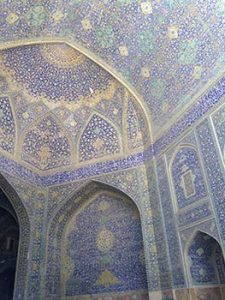 In the prayer hall of the Sheikh Lotfallah mosque – which was the private royal mosque and is said to be the most beautiful in the world – Saba and I lie down on our backs to meditate looking up at the dome. I feel like a particle in the universe of the mosque. It is indeed lovely: the symmetry of lattice window – arch – dome – repeat four times, is stunning. At the exit I am asked by a student to complete a survey about how to attract more visitors to Iran, in which one of the options is ‘dynamiting museums’!
In the prayer hall of the Sheikh Lotfallah mosque – which was the private royal mosque and is said to be the most beautiful in the world – Saba and I lie down on our backs to meditate looking up at the dome. I feel like a particle in the universe of the mosque. It is indeed lovely: the symmetry of lattice window – arch – dome – repeat four times, is stunning. At the exit I am asked by a student to complete a survey about how to attract more visitors to Iran, in which one of the options is ‘dynamiting museums’!
Our final sight to see here at Nagshe Jahan square is the Ali Qapou palace, but we stop first for a drink of fresh carrot and apple juice in another leafy, sheltered garden. We climb the spiral steps up to the roof terrace, for views of the whole city, and I pretend to be the Shah, looking down from his golden cushion to watch a polo game on the square below, or a parade, while musicians entertain him.
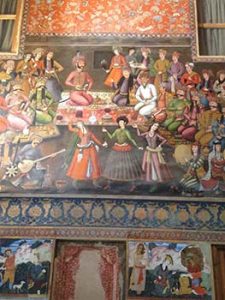 We drive out to Chehelsotoun palace, which reminds me a bit of the Taj Mahal. Or rather, its layout does. More glass, more paintings, and quite fascinating they are too. You can learn a lot about regal Persian life from studying the wall paintings here.
We drive out to Chehelsotoun palace, which reminds me a bit of the Taj Mahal. Or rather, its layout does. More glass, more paintings, and quite fascinating they are too. You can learn a lot about regal Persian life from studying the wall paintings here.
As if I hadn’t seen enough, Saba takes me next to the Armenian quarter in the Jolfa area of Isfahan. Vank cathedral is shaped like a mosque, as Armenian Christians were persecuted. It begins to drizzle, and I cry yet again; this time at the horror of the genocide. Telegraph cables are displayed, instructing the then Governor of Aleppo to ‘exterminate the entire population of Armenians in Turkey. Those opposing the orders will not be considered Government servants. Children, women and the sick are not to be spared. The modes of extermination are not to be differentiated. Without listening to the voice of conscience remove them all and put an end to their existence.’
There is nothing to say that doesn’t choke me, so we move out into the by now pouring rain, which is just as well as it serves as good cover for my expression of horror at the irony of a message like that going to Aleppo.
My last stops are two ancient bridges: they retain their robust but elegant character and are clearly a favourite strolling place, however, the rain prevents us from taking full advantage of this. Once again, I imagine the Shah sitting in the specially constructed royal viewing room, watching his people at leisure on the river or picnicking along the banks, or perhaps watching jugglers or dancers perform. Khaju bridge – apparently Iran’s oldest – has multiple arches, and I wander towards one, at Saba’s suggestion, to hear local people singing, a group of twenty or so, just standing under the bridge in the darkness, singing to each other and in unison, young and old together. Somehow that is a fitting end to my journey, people gathering to share a simple pleasure, united, peaceful, and relaxed.
Oh, Iran, you have captured my soul like no other place in such a short time. I will return.
If You Go:
Be sure to get a visa beforehand. The process will probably take longer than you expect, so allow plenty of time (it took me a couple of months and I had to travel to another city to collect it from the nearest Iranian embassy)
It is much easier to book through an agency and travel with a group. However, it is possible to book a tailor-made tour and travel with a guide. I recommend a personal guide called Saba.
And Samaneh at the Iran Traveling Center.
Dress appropriately: it is always important to respect other religions, even if you don’t have one of your own. If you are a woman, make sure you take a light headscarf to cover your hair.
Leave all media opinions behind.
Be prepared for a warm welcome.
About the author:
Maureen is an award-winning travel writer who has travelled the world, working as an adventure tour guide. Her first novel ‘More to Life,’ was published last year, and is available on amazon.com. It’s a humorous story about a middle-aged divorced woman who travels the world with her grown up children.
Photo credits:
Pasargad Tomb Cyrus by Bernd81 under the Creative Commons Attribution-Share Alike 4.0 International license.
All other photographs by Maureen Moss.




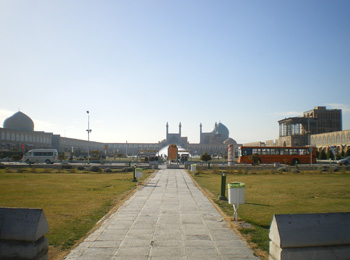
 It was early in the morning when I first walked into Nagh-e-Jahan square. It was a national holiday so people from all over the country had flocked to Isfahan. For me this meant the only available space in a hotel was little more than the floor of a converted underground storage room. Thoughts of such cramped accommodation made me happy to now be standing in one of the world’s largest squares. A huge open space, enclosed by covered arcades on each side is home to three of the high points of Persian, and world, architecture, the Imam(Shah) and Shekh Lotfollah mosques and the Ali Qapu palace.
It was early in the morning when I first walked into Nagh-e-Jahan square. It was a national holiday so people from all over the country had flocked to Isfahan. For me this meant the only available space in a hotel was little more than the floor of a converted underground storage room. Thoughts of such cramped accommodation made me happy to now be standing in one of the world’s largest squares. A huge open space, enclosed by covered arcades on each side is home to three of the high points of Persian, and world, architecture, the Imam(Shah) and Shekh Lotfollah mosques and the Ali Qapu palace. Getting up off the grass I walked toward the largest of Nagh-e-Jahan’s monuments, the Imam(Shah) mosque. Every inch of the sizeable structure is covered in blue and turquoise tiles, a speciality of Persian architecture. The mosque’s massive but intricately detailed gateway interrupts the plain brickwork of the surrounding arcades. The central arch alone climbs up to 27m with the two flanking minarets continuing further to reach 42m. Inscriptions in white Arabic script against a deep blue background frame central entrance. The rest of the space is filled with floral and geometric patterns in a mix of lighter colours. The level of detail is such that no corner, edge, or spot is left unadorned. This level of detail continues inside with over 400,000 painted tiles covering the arcades, halls and gateways of this extensive mosque complex. If the mosques of Nagh-e-Jahan square are the crowning glories of the Shah’s building programme then the domes are certainly the glittering jewels.
Getting up off the grass I walked toward the largest of Nagh-e-Jahan’s monuments, the Imam(Shah) mosque. Every inch of the sizeable structure is covered in blue and turquoise tiles, a speciality of Persian architecture. The mosque’s massive but intricately detailed gateway interrupts the plain brickwork of the surrounding arcades. The central arch alone climbs up to 27m with the two flanking minarets continuing further to reach 42m. Inscriptions in white Arabic script against a deep blue background frame central entrance. The rest of the space is filled with floral and geometric patterns in a mix of lighter colours. The level of detail is such that no corner, edge, or spot is left unadorned. This level of detail continues inside with over 400,000 painted tiles covering the arcades, halls and gateways of this extensive mosque complex. If the mosques of Nagh-e-Jahan square are the crowning glories of the Shah’s building programme then the domes are certainly the glittering jewels. The architects of the Safavid period (AD1501-1736) covered both the interior and the exterior of their domes in coloured tiles with colourful and impressive results. The Imam mosque is topped by an unblemished turquoise dome which fades paler and paler as the sun hits it. On the inside, yellow and cream floral patterns grow in circles against the blue background until this mass of individual details culminates in one central point at the top of the dome. Starring up into this pattern I could start to see that this wasn’t all about making something simply beautiful, these thousands of tiles were arranged to make a point. That the decorating pattern flows up, or flows down, from one central point was not just an aesthetic choice, it symbolises the climb up to heaven. The decoration of the mosque, like all art, is there to help people think of things beyond themselves.
The architects of the Safavid period (AD1501-1736) covered both the interior and the exterior of their domes in coloured tiles with colourful and impressive results. The Imam mosque is topped by an unblemished turquoise dome which fades paler and paler as the sun hits it. On the inside, yellow and cream floral patterns grow in circles against the blue background until this mass of individual details culminates in one central point at the top of the dome. Starring up into this pattern I could start to see that this wasn’t all about making something simply beautiful, these thousands of tiles were arranged to make a point. That the decorating pattern flows up, or flows down, from one central point was not just an aesthetic choice, it symbolises the climb up to heaven. The decoration of the mosque, like all art, is there to help people think of things beyond themselves. Perhaps not surprisingly there was more of a preference here for yellows and golds which are lit up by the sunlight flowing in through a series of windows. It says a lot that scholarly opinion suggests the Shekh Lotfollah is on a higher artistic level than even the Imam mosque. More effort and expense were put into this building and, while it is the smaller of the two, it is more embellished than its popular neighbour. The religious ideas motivating the decorations are again visible as I look up at the roof of the prayer hall. Circular patterns ascend in ordered rows to culminate at the top of the dome to inspire the visitor to contemplate the one centre.
Perhaps not surprisingly there was more of a preference here for yellows and golds which are lit up by the sunlight flowing in through a series of windows. It says a lot that scholarly opinion suggests the Shekh Lotfollah is on a higher artistic level than even the Imam mosque. More effort and expense were put into this building and, while it is the smaller of the two, it is more embellished than its popular neighbour. The religious ideas motivating the decorations are again visible as I look up at the roof of the prayer hall. Circular patterns ascend in ordered rows to culminate at the top of the dome to inspire the visitor to contemplate the one centre.
 The building programme of Shah Abbas also left a significant legacy spanning the river Zayendah. Numerous monumental bridges cross the wide stretch of water at Isfahan, some with foundations going back over a thousand years, but the longest is the Si-o-seh pol. During the day it is a long flat place to stroll along and combinations well with the grassy banks of the river to become an ideal place to rest in the afternoon. Covered niches line the sides of the bridge giving people dozens of semi-hidden spots to sit quietly looking out over the river. With evening the promenading crowds increase as do the numbers of river birds that flock over head.
The building programme of Shah Abbas also left a significant legacy spanning the river Zayendah. Numerous monumental bridges cross the wide stretch of water at Isfahan, some with foundations going back over a thousand years, but the longest is the Si-o-seh pol. During the day it is a long flat place to stroll along and combinations well with the grassy banks of the river to become an ideal place to rest in the afternoon. Covered niches line the sides of the bridge giving people dozens of semi-hidden spots to sit quietly looking out over the river. With evening the promenading crowds increase as do the numbers of river birds that flock over head.
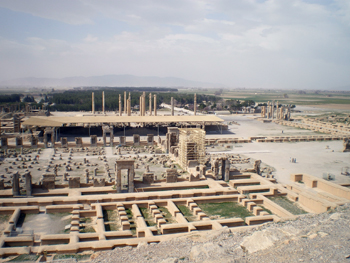
 It takes about an hour by car to cross the 70 kilometers of straight desert road to get to Takht-e-Jamshid, Persepolis. A little way outside the site are the rock-cut tombs of Naksh-e-Rustam. High up on a flat rock face the idealised figures of several Achaemenid kings glare out from a set of royal tombs. Cut so high that they were only accessible with ropes, I have to crane my neck and strain my eyes to make out the images of several Persian kings, the builders of Persepolis. Below the tombs the later Sassanian dynasty also left a vivid reminder. In this image the Iranian king Shapur I, sits tall astride his war-horse whilst in front a Roman emperor bends a knee and begs the king for mercy. All these thousands of years later the tombs and images still retain their main purpose of demonstrating the power of the Persian kings.
It takes about an hour by car to cross the 70 kilometers of straight desert road to get to Takht-e-Jamshid, Persepolis. A little way outside the site are the rock-cut tombs of Naksh-e-Rustam. High up on a flat rock face the idealised figures of several Achaemenid kings glare out from a set of royal tombs. Cut so high that they were only accessible with ropes, I have to crane my neck and strain my eyes to make out the images of several Persian kings, the builders of Persepolis. Below the tombs the later Sassanian dynasty also left a vivid reminder. In this image the Iranian king Shapur I, sits tall astride his war-horse whilst in front a Roman emperor bends a knee and begs the king for mercy. All these thousands of years later the tombs and images still retain their main purpose of demonstrating the power of the Persian kings.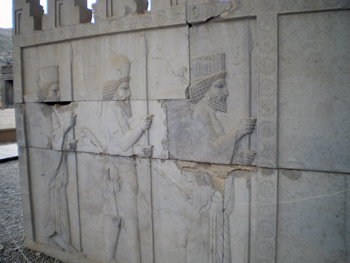 Over two thousand years ago people trekked into the Southern Iranian desert bearing tribute to the mighty Persian Empire whose king sat enthroned in the courtyards and spacious halls of Persepolis. This gave the grand city its reputation as the most hated in the world and ultimately caused its fiery destruction by Alexander the Great. It never recovered from this destruction and the hollowed out shade of the city was left abandoned to the desert for centuries.
Over two thousand years ago people trekked into the Southern Iranian desert bearing tribute to the mighty Persian Empire whose king sat enthroned in the courtyards and spacious halls of Persepolis. This gave the grand city its reputation as the most hated in the world and ultimately caused its fiery destruction by Alexander the Great. It never recovered from this destruction and the hollowed out shade of the city was left abandoned to the desert for centuries.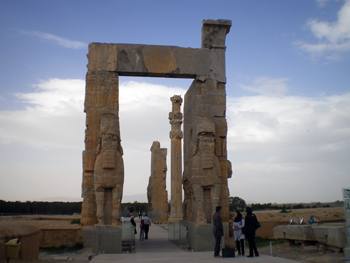 Once in the site, I came first to the impressive Gate of All Nations. The name referring to the subjects of the empire who would have had to pass through here. Above me loomed two huge human headed winged lions, their eroded bodies incised with the vertical and horizontal lines of three different languages which proclaim Xerxes I as their builder. The grand courtyard these beasts guard having long since vanished their intimidating bulk at least offers some protective shade. A little further on a finely carved capital of two bull’s heads lays flat on the ground. Unlike much else here they look fresh, pristine, as if just carved out of gleaming marble. It’s difficult to imagine that their huge weight could once have been hauled up to top a slender column.
Once in the site, I came first to the impressive Gate of All Nations. The name referring to the subjects of the empire who would have had to pass through here. Above me loomed two huge human headed winged lions, their eroded bodies incised with the vertical and horizontal lines of three different languages which proclaim Xerxes I as their builder. The grand courtyard these beasts guard having long since vanished their intimidating bulk at least offers some protective shade. A little further on a finely carved capital of two bull’s heads lays flat on the ground. Unlike much else here they look fresh, pristine, as if just carved out of gleaming marble. It’s difficult to imagine that their huge weight could once have been hauled up to top a slender column. One of the finest surviving elements of the site is the grand staircase which led to the Apadana Palace. The sides of the stairs contain some of the best surviving sculpture. It was here that the subject peoples would have to come bearing tribute. At the bottom of the staircase a lion grapples fiercely with a fleeing bull. This common piece of Persian iconography is still striking today. Climbing the staircase I was accompanied by the subject peoples. Greeks, Egyptians, Scythians, Afghans and a myriad others all processing up the steps to the palace at the top. The steps are cut deliberately shallow so you have to slow your pace and walk carefully before entering the presence of the King.
One of the finest surviving elements of the site is the grand staircase which led to the Apadana Palace. The sides of the stairs contain some of the best surviving sculpture. It was here that the subject peoples would have to come bearing tribute. At the bottom of the staircase a lion grapples fiercely with a fleeing bull. This common piece of Persian iconography is still striking today. Climbing the staircase I was accompanied by the subject peoples. Greeks, Egyptians, Scythians, Afghans and a myriad others all processing up the steps to the palace at the top. The steps are cut deliberately shallow so you have to slow your pace and walk carefully before entering the presence of the King. The fighting animals, strong soldiers and exotic subjects which lined the walls and the sheer opulence of the place must have made entering Persepolis an intimidating experience. Many from beyond Persia would only have come to Persepolis under compulsion. It is not surprising then that it was such a feared and hated place, the object of vengeful dreams for many people, despite its beauty. Once Alexander the Great defeated Persia and captured the city he had it burnt to the ground before leaving. As the architectural symbol of the Persian Empire, Alexander reckoned he could not leave it standing. The fire would have quickly rose and engulfed the wooden beams of the roof and brought them crashing down. Traces of this fiery end can still be seen across the site which was never rebuilt.
The fighting animals, strong soldiers and exotic subjects which lined the walls and the sheer opulence of the place must have made entering Persepolis an intimidating experience. Many from beyond Persia would only have come to Persepolis under compulsion. It is not surprising then that it was such a feared and hated place, the object of vengeful dreams for many people, despite its beauty. Once Alexander the Great defeated Persia and captured the city he had it burnt to the ground before leaving. As the architectural symbol of the Persian Empire, Alexander reckoned he could not leave it standing. The fire would have quickly rose and engulfed the wooden beams of the roof and brought them crashing down. Traces of this fiery end can still be seen across the site which was never rebuilt.

